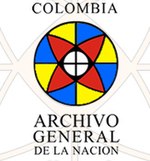| Archivo General de la Nación | |
 Logo of the General Archive. | |
 Headquarters of the General Archive. | |
| Agency overview | |
|---|---|
| Formed | 22 December 1989 |
| Headquarters | Carrera 6 No. 6-91 Bogotá, D.C., Colombia 4°35′38.17″N 74°4′36.84″W / 4.5939361°N 74.0769000°W |
| Annual budget |
COP$15,322,278,768 (2011)
[1] COP$18,537,174,113 (2012) [2] COP$18,916,749,945 (2013) [3] |
| Agency executive |
|
| Parent agency | Ministry of Culture |
| Website |
www |
The General Archive of the Nation ( Spanish: Archivo General de la Nación) is a Colombian government agency ascribed to the Colombian Ministry of Culture charged with "conserving the historical legacy, as well as recovering and circulating the documentary heritage of the country". It is the head of the National System of Archives. The headquarters are located in the city of Bogotá and was designed by the architect Rogelio Salmona.
Contents
The archive contains historical documents that date from 1541 to 1991. These documents include constitutional policies, notarized documents, judicial documents from colonial times, letters from famous historical figures such as Simón Bolívar, and historical maps of the New Kingdom of Granada. The collections has documents from all periods of the history of the Americas, from the conquest to the present day. In addition to material from Colombia, the archive has documents from the territories that formed the New Kingdom of Granada as well as from the later countries of Gran Colombia, Venezuela, Panama, and Ecuador. There are also documents from Central America, Peru, and Chile. A collection of documents titled "Negros y Esclavos" (Blacks and Slaves) was featured by UNESCO as part of its Memory of the World Programme. [4]
See also
References
- ^ Colombia, Congress of (13 December 2010). "Ley 1420 de 2010" (PDF). Diario Oficial (in Spanish) (47, 922). Bogotá: 28. ISSN 0122-2112. OCLC 500057889. Retrieved 6 May 2013.[ permanent dead link]
- ^ Colombia, Congress of (14 December 2011). "Ley 1485 de 2011" (PDF). Diario Oficial (in Spanish) (48, 283). Bogotá: 14. ISSN 0122-2112. OCLC 500057889. Archived from the original (PDF) on 9 January 2014. Retrieved 6 May 2013.
- ^ Colombia, Congress of (10 December 2012). "Ley 1593 de 2012" (PDF). Diario Oficial (in Spanish) (48, 640). Bogotá: 13. ISSN 0122-2112. OCLC 500057889. Archived from the original (PDF) on 9 January 2014. Retrieved 6 May 2013.
- ^ "Negros y Esclavos Archives | United Nations Educational, Scientific and Cultural Organization". www.unesco.org. Retrieved 2018-05-25.
| Archivo General de la Nación | |
 Logo of the General Archive. | |
 Headquarters of the General Archive. | |
| Agency overview | |
|---|---|
| Formed | 22 December 1989 |
| Headquarters | Carrera 6 No. 6-91 Bogotá, D.C., Colombia 4°35′38.17″N 74°4′36.84″W / 4.5939361°N 74.0769000°W |
| Annual budget |
COP$15,322,278,768 (2011)
[1] COP$18,537,174,113 (2012) [2] COP$18,916,749,945 (2013) [3] |
| Agency executive |
|
| Parent agency | Ministry of Culture |
| Website |
www |
The General Archive of the Nation ( Spanish: Archivo General de la Nación) is a Colombian government agency ascribed to the Colombian Ministry of Culture charged with "conserving the historical legacy, as well as recovering and circulating the documentary heritage of the country". It is the head of the National System of Archives. The headquarters are located in the city of Bogotá and was designed by the architect Rogelio Salmona.
Contents
The archive contains historical documents that date from 1541 to 1991. These documents include constitutional policies, notarized documents, judicial documents from colonial times, letters from famous historical figures such as Simón Bolívar, and historical maps of the New Kingdom of Granada. The collections has documents from all periods of the history of the Americas, from the conquest to the present day. In addition to material from Colombia, the archive has documents from the territories that formed the New Kingdom of Granada as well as from the later countries of Gran Colombia, Venezuela, Panama, and Ecuador. There are also documents from Central America, Peru, and Chile. A collection of documents titled "Negros y Esclavos" (Blacks and Slaves) was featured by UNESCO as part of its Memory of the World Programme. [4]
See also
References
- ^ Colombia, Congress of (13 December 2010). "Ley 1420 de 2010" (PDF). Diario Oficial (in Spanish) (47, 922). Bogotá: 28. ISSN 0122-2112. OCLC 500057889. Retrieved 6 May 2013.[ permanent dead link]
- ^ Colombia, Congress of (14 December 2011). "Ley 1485 de 2011" (PDF). Diario Oficial (in Spanish) (48, 283). Bogotá: 14. ISSN 0122-2112. OCLC 500057889. Archived from the original (PDF) on 9 January 2014. Retrieved 6 May 2013.
- ^ Colombia, Congress of (10 December 2012). "Ley 1593 de 2012" (PDF). Diario Oficial (in Spanish) (48, 640). Bogotá: 13. ISSN 0122-2112. OCLC 500057889. Archived from the original (PDF) on 9 January 2014. Retrieved 6 May 2013.
- ^ "Negros y Esclavos Archives | United Nations Educational, Scientific and Cultural Organization". www.unesco.org. Retrieved 2018-05-25.